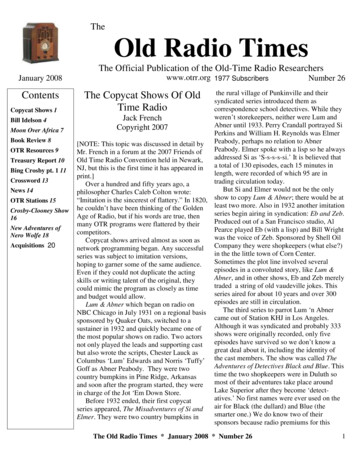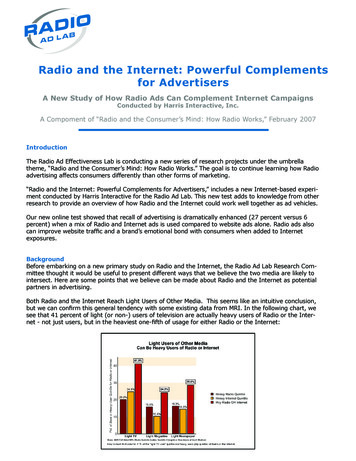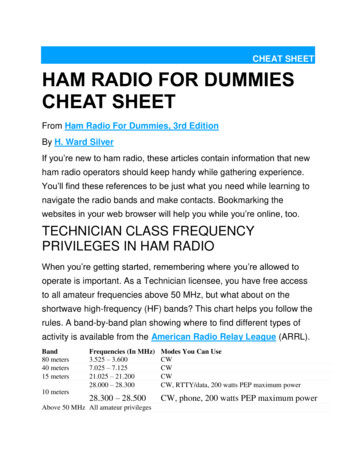
Transcription
TheOld Radio TimesThe Official Publication of the Old-Time Radio ResearchersJanuary 2008ContentsCopycat Shows 1Bill Idelson 4Moon Over Africa 7Book Review 8OTR Resources 9Treasury Report 10Bing Crosby pt. 1 11Crossword 13News 14OTR Stations 15Crosby-Clooney Show16New Adventures ofNero Wolfe 18Acquisitions 20www.otrr.org 1977 SubscribersNumber 26the rural village of Punkinville and theirsyndicated series introduced them ascorrespondence school detectives. While theyweren’t storekeepers, neither were Lum andJack FrenchAbner until 1933. Perry Crandall portrayed SiCopyright 2007Perkins and William H. Reynolds was ElmerPeabody, perhaps no relation to Abner[NOTE: This topic was discussed in detail byPeabody. Elmer spoke with a lisp so he alwaysMr. French in a forum at the 2007 Friends ofaddressed Si as ‘S-s-s-s-si.’ It is believed thatOld Time Radio Convention held in Newark,a total of 130 episodes, each 15 minutes inNJ, but this is the first time it has appeared inlength, were recorded of which 95 are inprint.]trading circulation today.Over a hundred and fifty years ago, aBut Si and Elmer would not be the onlyphilosopher Charles Caleb Colton wrote:showto copy Lum & Abner; there would be at“Imitation is the sincerest of flattery.” In 1820,least two more. Also in 1932 another imitationhe couldn’t have been thinking of the Goldenseries begin airing in syndication: Eb and Zeb.Age of Radio, but if his words are true, thenProduced out of a San Francisco studio, Almany OTR programs were flattered by theirPearce played Eb (with a lisp) and Bill Wrightcompetitors.was the voice of Zeb. Sponsored by Shell OilCopycat shows arrived almost as soon asCompany they were shopkeepers (what else?)network programming began. Any successfulin the the little town of Corn Center.series was subject to imitation versions,Sometimes the plot line involved severalhoping to garner some of the same audience.episodes in a convoluted story, like Lum &Even if they could not duplicate the actingAbner, and in other shows, Eb and Zeb merelyskills or writing talent of the original, theytradeda string of old vaudeville jokes. Thiscould mimic the program as closely as timeseries aired for about 10 years and over 300and budget would allow.episodes are still in circulation.Lum & Abner which began on radio onThe third series to parrot Lum ‘n AbnerNBC Chicago in July 1931 on a regional basiscameout of Station KHJ in Los Angeles.sponsored by Quaker Oats, switched to aAlthoughit was syndicated and probably 333sustainer in 1932 and quickly became one ofshows were originally recorded, only fivethe most popular shows on radio. Two actorsepisodes have survived so we don’t know anot only played the leads and supporting castgreat deal about it, including the identity ofbut also wrote the scripts, Chester Lauck asColumbus ‘Lum’ Edwards and Norris ‘Tuffy’ the cast members. The show was called TheAdventures of Detectives Black and Blue. ThisGoff as Abner Peabody. They were twotime the two shopkeepers were in Duluth socountry bumpkins in Pine Ridge, Arkansasmost of their adventures take place aroundand soon after the program started, they wereLake Superior after they become ‘detectin charge of the Jot ‘Em Down Store.atives.’ No first names were ever used on theBefore 1932 ended, their first copycatair for Black (the dullard) and Blue (theseries appeared, The Misadventures of Si andsmarter one.) We do know two of theirElmer. They were two country bumpkins insponsors because radio premiums for thisThe Copycat Shows Of OldTime RadioThe Old Radio Times * January 2008 * Number 261
always wanted a sidekick who would call me that.)series still exist; a Sherlock Holmes type cap from IodineLike The Shadow, Dumont’s sole purpose in life wastoothpaste and a brass badge from Folger’s Coffee.to use his great wisdom and powers of concentration toThis show aired from October 1932 to February 1934.Despite the claim by their announcer that their adventures fight against crime and evil, thus bringing the guilty tojustice. CBS aired this show for the summer of 1949 withwere ‘thrilling and amusing’ there is nothing in thesurviving copies to confirm either attribute. The writing is Paul Frees in the title lead and Ben Wright as Toku,sounding a lot like Charlie Chan. (Typical saying of Toku:pedestrian and in most episodes the only action has‘It is written that darkness is the best armor for unarmedalready happened and Black and Blue merely recite theirman.’) Norman McDonnell directed this series, andmemory of the incidents. Their slogan ‘Detectives Blackdespite its short run, he backed up the leads with strongand Blue---good men, tried and true’ was used on mosttalent in supporting roles: Bill Conrad, Harry Bartell,episodes.Georgia Ellis, Larry Dobkin, and Jack Kruschen. A totalOut of Detroit’s WXYZ in 1936 came The Greenof three shows have survived.Hornet. With largely the same cast and crew of theThe origin of the husband and wife detective team waspopular Lone Ranger, this modern-day crime fighter tookthe 1934 novel ‘The Thin Man’ by Dashiell Hammettto the air to the music of ‘Flight of the Bumble Bee’which introduced Nick and Nora Charles. However it wascomposed by Rimsky-Korsakov. Within three years TheGreen Hornet was so popular its name inspired a copy cat the movies about them, starring William Powell andcomic book, The Blue Beetle, however the chief similarity Myrna Loy, which popularized them as a funny, sexycouple who happened to solve murder mysteries. By thewas in the names. The Blue Beetle was Dan Garrett, atime the third movie in The Thin Man series finished itspoliceman, who operated without a sidekick like Kato.However when The Blue Beetle came to radio, they found run, the husband and wife team of Richard and FrancesLockridge jumped on the bandwagon with a carbon copya theme song that sounded quite a bit like that of theduo called Pam and Jerry North, who made their 1940Green Hornet’s. And like the WXYZ hero, The Bluedebut in the novel “The North’s Meet Murder.”Beetle hid behind a mask, fought crime, and was aOther than the occupations of the two husbands, thereproblem for the local police.is virtually nothing to distinguish the Charles’ from theThe Shadow of the pulp magazines used mentaltelepathy, mind control, and if those didn’t work, he relied Norths’. Both were a married duo who solved murdermysteries in Manhattan, were wealthy, sexy, sophisticated,upon two blazing .45 automatics. But when he came toapartment dwellers, loved parties, drank lots of alcohol,star in his own radio show in 1937 (no longer just a shillfor Street & Smith’s Detective Story Magazine on the air) had late breakfasts but never cooked a meal, and movedabout in posh circles. One minor difference was that thehe was not only unarmed but also reduced to only oneCharles’ had a pet dog while the copycat Norths,’special power: to obscure the minds of men (andappropriately, had cats.presumably, women) so The Shadow was renderedThe two couples were as similar on radio as they wereinvisible. As Lamont Cranston, he was usually describedas a ‘wealthy young man about-town who years ago in the on the printed page or in the movies, perhaps more so.Adventures of the Thin Man began in 1941 on NBC andOrient learned the strange secret to cloud men’s minds’Mr. and Mrs. North followed a year later, on the sameIt would be twelve years before a copy cat of TheShadow arrived in 1949; it was called The Green Lama. It network. Both series would remain on the air for severalyears with the copycats actually outlasting the originals byshould be noted this is spelled with one ‘l’ so he was notan emerald-colored, beast of burden in the Andes; he was five years, ending in 1955. But even today, many OTRa Buddhist monk . . . well, sorta. The character was named fans have trouble telling the two series apart.A West Coast fictional couple who solved crimes onJethro Dumont, described as a wealthy young man aboutradio was also subjected to being copied – almost word fortown, who years ago in the Orient (specifically a Tibetanword. They began with Frances Crane, a talented ladymonastery) learned many strange secrets and curiouspowers. He actually had a few powers The Shadow didn’t who in 1941 created the San Francisco detective, PatAbbott, and in his mystery novels, made his wife, Jean,have, including causing bullets to never strike him andthe narrator of the plots. Crane’s characters came to radiolocating objects hundreds of miles away by going into aon Abbott Mysteries on Mutual in 1945 and then ran fortrance. Dumont had a constant companion that was nocompetition to Margot Lane. The sidekick was a native of three consecutive summers. The series was resurrected byTibet whose name was pronounced ‘Toku’ and he usually NBC in 1955 under the new title of The Adventures of theAbbotts and this nudged Mutual into producing a copycataddressed Dumont as ‘Exalted One.’ (Somehow I’ve2The Old Radio Times * January 2008 * Number 26
all but the last five months of the show , when it was ashow under the title It’s a Crime, Mr. Collins. The seriessustaining program with Steve Dunne in the lead. By thatfeatured Greg and Gail Collins in a flagrant rip-off of thetime, Wildroot had switched to a new version of SamAbbotts in which only the names had been changed.Spade which they called Charlie Wild, Private Eye andMutual even used Crane’s habit of putting a color in thethey cast George Petrie in the lead. Although Wild workedtitle of every story, i.e. ‘The Pink Lady’, ‘The Chromein New York City, not San Francisco like Spade, WildYellow Death’, ‘Red Hot Mama.’still had the services of Spade’s secretary, Effie Perrine.Here’s what Crane wrote, describing how Jean, in herown words, met Pat Abbott, the man she would eventually While this series could be called an ‘authorized copy,’another series was to mimic Sam Spade more closely, butmarry:under a different title.‘I was lucky to hook a tall, lean, interesting-lookingIn 1952 ABC launched a detective series called AWesterner like Patrick Abbott. We had met in my curioshop in Santa Maria, New Mexico. But he’d been yanked Crime Letter from Dan Dodge, a blatant steal from TheAdventures of Sam Spade. (Math majors will immediatelyback to his San Francisco office to do some detecting fornote that both Spade and Dodge had the exact samethe U.S. government.’number of letters in both their first and last names.) ButIn the first episode of It’s a Crime, Mr. Collins, Gailthere were more striking similarities in the 1952-53introduces herself to the radio audience and tells themnetwork copy cat. Both began every episode with thehow she first met Greg.private eye telephoning his secretary and explaining his‘I knew Greg was for me from the first moment helatest caper; in the Dan Dodge series, Myron McCormickwalked into my curio shop in New Mexico. Greg . . . tall,played the detective who called his secretary, “Susie,”lean, slightly on the Western side. After we’d met, Gregportrayed by Shirley Eggleston. And they even ended eachwent on a secret assignment for the U.S. Government;program of Dan Dodge with the theme music, ‘Goodnighthe’s a private eye.’Sweetheart,’ just like Sam Spade. Only one audio copy ofWhen ABC began the crime series Danger, Dr.Danfield in 1946 many listeners thought it was an original A Crime Letter from Dan Dodge has survived and weshow. But it wasn’t; it was a direct steal from Crime Files have to thank Shirley Eggleston for saving it and makingit available to the OTR community.of Flamond which had debuted on WGN in 1944 (withMike Wallace in the lead) as a regional show and thenlater aired on Mutual. Flamond was a crime psychologistwho, with the aid of his ever present secretary namedSandra Lake, dedicated his life to solving mysteriouscrimes. However, he was more interested in the “why” ofcrime, rather than the “how,” and he began and endedevery episode dictating to his secretary.Danfield, who was a crime psychologist, was also moreinterested in the “why” of crime, rather than the “how”and he too began and ended every episode dictating to hissecretary, Rusty Fairfax. The only difference between thetwo series was that Rusty was a lot more annoying thanSandra.Flamond was on the air from the mid-40s until 1948and then returned for six months in 1953. The copycatversion was on ABC for a year and then kept insyndication by Teleways Transcription Company though1951. Nine episodes survive of Flamond and 26 ofDanfield.Steve Dunne, who was the voice of Dr. Danfield, isalso connected to another series that was imitated with acopy cat show. Dashiell Hammett created not only NickCharles, but also Sam Spade. This latter detective was onthe air from 1946 to 1951 under the sponsorship ofWildroot Cream Oil. Howard Duff was the title lead for3The Old Radio Times * January 2008 * Number 26
home an’ you tell him you’ve made arrangements for youan’ him to go with Mr. An’ Mrs. Stembottom to the Bijouan’ see Gloria Golden.SADE: [laughs] Yeah.By Jeff KallmanRUSH: Let’s knock on the window and give him a jollywaveof the hand.The last surviving resident of the small house halfwaySADE: You just want to aggravate him some more?up in the next block died New Year's Eve. Somehow itRUSH: [chuckles] No.seems unfair that even one of that wonderful, understatedSADE: [giggles] Ya do to. Lands, baseball. What iscompany of "radio's home folks" should have gone to histhereto it to get so upset about?reward on so festive a day.RUSH: Oh, there’s thousands of ins an’ outs.But then you get the sense that, knowing mastermindSADE: Maybe for kids. But grown-up men like Gov an’Paul Rhymer, there might always be a shuddering chuckleMr. Drummond—what do they care?to be found in the thought that even one of his gentlyRUSH: You just don’t comprehend the Nationaloffbeat Gook family should go on such a day.Pastime, Mom.Television fans, of course, remember Bill Idelson firstSADE: I guess I don’t.as the nebbish, mama's-boy, semi-steady boyfriend,RUSH: See, it’s the Big Leagues that interest Gov an’Herman Glimscher, of amorous comedy writer SallyMr. Drummond. Here we got a bunch of large cities allRogers (The Dick Van Dyke Show); and, later, as arepresented by baseball team. New York, Chicago,respected writer (The Andy Griffith Show; The TwilightBoston, Philadelphia—-Zone; The Bob Newhart Show; M*A*S*H; others), and itSFX: [Door slams.]credits him that he was given to work for the better amongSADE: [raises voice] Hello there, mister.the medium's offerings.VIC: [cheerily enough] Hi, everybody. How’s tricks?But perhaps it was the aesthetic, the understatement,SADE: All right.and the gentle skill under which he was allowed toRUSH: [as door closes] I must of missed ya along thedevelop on Vic & Sade that informed Idelson in his postalleysome place, Gov. I got home about two minutesold-time radio years. His Rush Gook seemed never quitebefore you did.to have been the stereotypically dopey radio teenager,VIC: Drummond an’ I saw you up ahead. We didn’tdisplaying an unpolished intelligence and absurdism thatholler an’ ask ya to join us because we were in no moodwould have left the Henry Aldriches, Archie Andrewses,for crude company.and Brewster Boys of the time lost in their malt shopsRUSH: I see.needing maps to get from the soda fountain to the boys'VIC: [to Sade] Paper come yet?bathroom, never mind to where the girls were.SADE: I doubt it. Boy very seldom shows up this early."I think I knew, right from the start, that Vic & SadeWhatwere you an’ Mr. Drummond havin’ such a to-dowas something very special, very wonderful, and I believeabout?I did appreciate the humour right from the beginning,"VIC: When?Idelson told Richard Lamparski, in an October 1971 radioSADE: Just now by the garbage box. We saw youinterview, his voice even then retaining enough of Rush'sthrough the window.slightly nasal roll, while advancing the book that becameVIC: What makes ya think we were havin’ what youThe Story of Vic & Sade, the affectionately sober book heare pleased to call a “to-do”?wrote about the show.RUSH: Never saw so much arm wavin’ in my life.SADE: Baseball’s just a game ain’t it?VIC: The arm wavin’ you saw through the window willRUSH: Well, yes an’ no. It’s kind of a business, too.innoway unbalance the equilibrium of the world. LifeProfessional baseball players go down to the diamondwill go on as before.after dinner just like Gov goes down to the office. TheySADE: No, but a person watchin’ would get the ideagot wives an’ children an’—youfellas were about to have a fight.SADE: Guess the argument’s just about over. HereVIC: That may come to pass one of these days. [tocomes Gov toward the house.himself]The big boob.RUSH: He acts like Mr. Drummond got the best of him.SADE: Who--Mr. Drummond?See the little quick steps he takes an’ the way his face is?VIC: Yes, Mr. Drummond.SADE: [giggles] Uh-huh.SADE: Are ya mad at him?RUSH: That’s the expression he gets when he comes4The Old Radio Times * January 2008 * Number 26Bill Idelson, RIP: The Last of theHome Folks
VIC:I wouldn’t exactly condescend to get mad at acreature so handicapped. Mr. Drummond is short thenormal quota of brains. Mr. Drummond moves helplesslyin a fog of stupidity. Mr. Drummond, in short, is a halfwit.SADE: [giggles] Did you tell him that?VIC: I intimated as much—an’ more—only I couchedmy barbs with such subtlety they went over his head likesoft summer clouds.RUSH: Baseball, huh, Gov?VIC: How’s that?RUSH: You an’ him were discussin’ baseball?VIC: One could hardly refer to it as a discussion. I’dvouchsafe a thoughtful opinion an’ Drummond’d comeback with a splatter of meaningless words boorishlystrung together.RUSH: But it was baseball you were talkin’ about?VIC: Yes.RUSH: [chuckles] See, Mom?SADE: I was just askin’ Rush, Vic, how grown-up mencan work theirself into a frenzy about such stuff.VIC: Am I worked into a frenzy?SADE: You acted like you were worked into somethingout by the garbage box just now. You an’ Drummondboth.VIC: What did Mr. Rush reply when you quizzed him?SADE: [giggles] He said he didn’t know.VIC: That would be his rejoinder when quizzed on anytopic, I believe.---From Vic & Sade, "Sade Thinks Baseballis Just a Game," 1938.For The Story of Vic & Sade, Idelson took his owntrekking to the University of Wisconsin to read some fivethousand of the first five years of the show's scripts. "PaulRhymer is one of the great geniuses who ever lived, inshow business," Idelson told Lamparski, "and I think it'sjust unfortunate that his work was done mainly in radio,which was such an ephemeral sort of medium, and thath iswords went out over the air and then sort of disappeared.This is, really, the big reason I wrote the book, I wouldlike to bring back some of the great writing this man did,and I would like people to be able to see it and appreciateit.""Some 7,000,000 radio fans," wrote Time in lateDecember 1943, "would find life harder to bear withoutVic & Sade."as doubletalk. Vic, a typical, unpretentiousbookkeeper for a kitchenware company,and Sade, his natively bright, homeboundwife, in eleven years have built themselvesconsiderable prestige as symbols of U.S.small-town living.They spend 15 minutes a day five times aweek dramatizing the failure of the butcherto deliver the meat, the business of buyinga Christmas present for the boss, thequestion of closed barbershops on Sunday,etc. They, plus their adopted son Russell,plus Uncle Fletcher, an absentminded,somewhat deaf, minutely anecdotal citizen,are the chief characters in the show. Butthe actors who play these four talk aboutan odd assortment of town characters whonever appear.They include Mr. Buller, Vic's businessassociate, who pulls his own teeth; R. J.Konk, founder of Vic's lodge, the SacredStars of the Milky Way; Ruthie Stembottom, a family friend; Godfrey Dimlok,who invented a bicycle that could say"mama"; the Brick Mush (Vic & Sade'sfavorite breakfast food) salesman, whocries almost all of the time; BluetoothJohnson; Cora Bucksaddle; OleChinbunny; Rishigan Fishigan of Sishigan,Michigan; Smelly Clark, and others.How these charactersmanage to convey reality to radio listenersis something of a mystery even to AuthorRhymer. He does not know how he does it,and is inclined to give the credit to actorsBernardine Flynn, a fugitive from EugeneO'Neill's Strange Interlude, and Art VanHarvey, ex-grain broker, advertising manand vaudevillian, who have played Sade &Vic Gook from the beginning. SaysRhymer: "They could read aloud from thetelephone directory and soundentertaining."HOW DOES HE DO IT?Idelson was hired for the show originally after Art VanThey would also find it difficult to explain why. It is a soap Harvey (Vic), who often visited the Prohibition blind pigsaloon run by Idelson's father, suggested the boy would beopera in which nothing much ever happens. But it is asright for playing Rush. He also performed in six otherAmerican5The Old Radio Times * January 2008 * Number 26
radio series based out of Chicago, Vic & Sade's originalhome base, including Uncle Walter's Doghouse, SecretCity, and playing Skeezix, when the venerable comicGasoline Alley got a first crack on radio."They're getting fewer and farther in between," saidIdelson, a little sadly, when asked whether people stillremembered him, in 1971, for Vic & Sade. "I think theobituaries are grabbing them off now."You can take Paul Rhymer away from the performer,but you can't really take the performer away from PaulRhymer. About the only thing that did, in Idelson's case,was a tour in the Navy during World War II, for which hewas awarded the Distinguished Flying Cross and four AirMedals.Idelson and his wife, actress Seemah Wilder, raisedfour children, one of whom, Ellen, became a distinguishedtelevision comedy writer in her own right (The Nanny,Boy Meets World, Will & Grace), before the obituariesgrabbed her off, prematurely, four years ago."Live radio is something else," mused Idelson, whomight as well have been doing it live when Vic & Sadewas recorded on transcription discs. "There was a tensionconnected with live radio that I don't think ever has beenduplicated in any other medium. You knew that any breathyou took, or anything you said, was heard by millions ofpeople out there and, once said, could never be retracted.And at one point or another, I think every radio actorbecame suddenly, and terribly, aware of this phenomenon.And it spawned something known as mike fright, and Idon't think any radio actor was ever free of it."The mike fright didn't drive Idelson away from acting;the income did. He found himself getting more workwriting than acting and, seemingly, found himself makingthe transition as seamlessly as Vic, Sade, and Rushtransitioned from Mr. Chinbunny's ice cream cravings toRush's bid for a Bijou lifetime pass. He also earned theadmiration of Norman Corwin, who introduced The Storyof Vic & SadeHe was a luminary. He stood out amongthe radio comedians, and he stood outbecause of very good writing by PaulRhymer and very good acting by himself. Ihad nothing but admiration for this fellow.went far enough to ensure that Vic & Sade, its cast, and itsauthor, have not been sentenced to ephemera, after all.They remain beyond time and place. If the core belongedto its writer and mastermind, in the hands of a differentcompany of performers it might have quite a differenttelephone book from the small house halfway up in thenext block.Moon Over Africa Issued As ACertified SeriesNot much is known about the radio series Moon OverAfrica. It is thought to be a South African radio showwhich aired around 1937 or 1938. There are 26 episodeslasting 15 minutes each. Since nothing is really knownabout the series we are not sure if there were episodeswhich aired before, or after, these 26 episodes. It'sunknown if the series was broadcast in the US. TalbotMundy wrote the series script (and is known for otherserials such as Jack Armstrong, Lost Empire, and GhostCorps.).The 26 episodes follow an expedition led by ProfessorAnton Edwards as they search for the missing city ofAtlantis.They follow the directions of a shrunken head whichspeaks the ancient language of the people of Atlantis andrun into many strange dangers in the African jungle.The Old Time Radio Researchers Group would like tothank the following people who helped on this series Series Coordinator - James BlazierQuality Listener(s) - James BlazierSeries Synopsis - Danny ClarkAudio Briefs Announcer(s) - Fred Bertlesen, Danny ClarkAudio Briefs Compiler(s) - Fred Bertlesen, Danny ClarkPictures, other extras - NoneArtwork - Jim BeshiresStars Bios - NoneAnd all the members and friends of OTRR for theircontributions of time, knowledge, funds, and othersupport.---Corwin, to the Los Angeles TimesToo many Vic & Sade discs were lost when a sponsorclearing clutter destroyed them without a thought, butmany enough managed to survive or turn up unexpectedly,perhaps prodded by Idelson's own volume. That effortThe Old Radio Times * January 2008 * Number 266
Moon Over Africa - A ReviewHank HarwellSome time ago, I listened to Moon Over Africa, a1930's-era adventure radio show that I acquired.It was written by famed adventure writer TalbotMundy, and apparently ran for three years, although I amonly in possession of twenty-six episodes. But what pulpyfun are contained in those twenty-six twenty-minuteepisodes! They feature the adventures of Professor AntonEdwards, a Great War veteran, who is portrayed as beingin his early 60's, yet still possesses remarkable physicalstrength and an amazing marksmanship with a rifle. He isaccompanied by his daughter Lorna and Jack, Lorna'sbeau and Professor Edwards' assistant. Rounding out theteam is Nguru, a Masai prince who 'has been with'Professor Edwards for many years.At the beginning of the first episodes in the collection,the party is in search of a lost colony of Atlantis, directedby a severed and preserved human head, which cacklesinsanely and 'speaks' to the group in a language theprofessor is convinced is Atlantean. They encounter a cityof lost medieval crusaders, a prehistoric land inside thecrater of a long-dormant volcano, a village of cannibals,another village of ape-like men, yet another village ofapparent were-leopards, and a lost Roman treasure hoard.There are approximately three story arcs within thetwenty-six episodes, and at least seven separateadventures, with each adventure lasting no more thanthree or four episodes apiece. The pacing is fast, yet not somuch so that you cannot keep up.At the beginning of each episode there is a helpfulsummary of what has transpired before to get newlisteners 'up to speed.' Music is minimal. In fact, the onlymusic I recall hearing was in the last episode, and it wasused in such a way as to indicate the passage of time.Other than that, the only music present is the beatingdrums of the intro, which sonorously proclaim "Africandrums are talking."Each intro is unique, and serves to set the mood for thepiece, describing Africa as a land of beauty and mysteryand adventure. The intros are exceptionally well-written.Due to a question from a friend, after my initial review,I paid a little more attention to the audio quality. Fromwhat my inexpert ears could determine, sound quality wasfine (considering the 70-years-plus age of the programs),except for about three of the episodes, where the volumedropped out considerably. However, it was not tooobjectionable, and I could still make out what eachcharacter was saying (please also remember that I waslistening to these shows with the audio being pumpeddirectly into my ears via ear-buds).On the negative side, Moon Over Africa suffers frommany of the politically-incorrect foibles of its time. Lornais prone to being attracted to gold and gems (especiallydiamonds), being unnerved by an apparent supernaturalencounter, even fainting dead away from fear, and beingthe object of a primitive man's desire. Professor Edwardsand Jack are portrayed as noble, knowledgeable, virile,and moral white men. Nguru is portrayed as a pidginEnglish-speaking brute with a heart of gold, who isfrequently given to rescuing 'Missy,' that is Lorna.Professor Edwards often uses racist comments to addressNguru, such as 'black sinner,' or he comes across as verypatronizing to the Masai culture, as any good whiteEuropean/American would.Aside from these, I really enjoyed this series. It hasquickly vaulted to top of the list of my favorites. I wish Ihad the rest of the episodes.As I listened, I was struck with the thought that withvery little alteration, Moon Over Africa could be easilyadapted to a pulp rpg campaign. In fact, it already is acampaign. It possesses story arcs and adventures withinthose arcs. There are fairly well-defined characters, andthe villains have a definite goal in mind for their villainy,and the adventure is rip-roaring, over-the-top. While Ihaven't forgotten (or finished yet) Gonne Island, I thinkmy next attempt will be Moon Over Africa.It is well worth the listen.The Old Radio Times * January 2008 * Number 267
You’ll Be Seeing StarsAs You Look into Their LivesA book review by Jim Coxmakes it a keepsake for the pictures alone.Featured in the work are Bob Barker, Jack Barry, DickClark, Bud Collyer, Bill Cullen, John Daly, Bob Eubanks,Monty Hall, Dennis James, Allen Ludden, Peter Marshall,Wink Martindale, Garry Moore, Bert Parks, Regis Philbin,Gene Rayburn, Pat Sajak, Alex Trebek and 14 more icons.This handsome edition, Television Games Show Hosts,is available now from www.mcfarlandpub.com and 800253-2187 for 55. Any who enjoy biography ofcharismatic entertainment figures won’t be disappointedwith this one I’m virtually certain.Television Game Show Hosts by David Baber, arecently released hardback by McFarland & Company,is—in the writer’s opinion—one of the best biographicalcompendiums to come down the pike in a long while. Asone accustomed to penning similar vignettes aboutentertainment legends, I wholeheartedly endorse Baber’s13-year pilgr
popular Lone Ranger, this modern-day crime fighter took to the air to the music of 'Flight of the Bumble Bee' composed by Rimsky-Korsakov. Within three years The Green Hornet was so popular its name inspired a copy cat comic book, The Blue Beetle, however the chief similarity was in the names. The Blue Beetle was Dan Garrett, a










